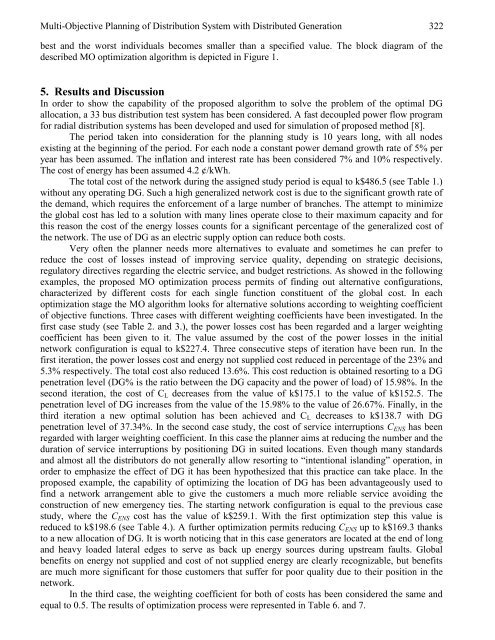European Journal of Scientific Research - EuroJournals
European Journal of Scientific Research - EuroJournals
European Journal of Scientific Research - EuroJournals
Create successful ePaper yourself
Turn your PDF publications into a flip-book with our unique Google optimized e-Paper software.
Multi-Objective Planning <strong>of</strong> Distribution System with Distributed Generation 322<br />
best and the worst individuals becomes smaller than a specified value. The block diagram <strong>of</strong> the<br />
described MO optimization algorithm is depicted in Figure 1.<br />
5. Results and Discussion<br />
In order to show the capability <strong>of</strong> the proposed algorithm to solve the problem <strong>of</strong> the optimal DG<br />
allocation, a 33 bus distribution test system has been considered. A fast decoupled power flow program<br />
for radial distribution systems has been developed and used for simulation <strong>of</strong> proposed method [8].<br />
The period taken into consideration for the planning study is 10 years long, with all nodes<br />
existing at the beginning <strong>of</strong> the period. For each node a constant power demand growth rate <strong>of</strong> 5% per<br />
year has been assumed. The inflation and interest rate has been considered 7% and 10% respectively.<br />
The cost <strong>of</strong> energy has been assumed 4.2 ¢/kWh.<br />
The total cost <strong>of</strong> the network during the assigned study period is equal to k$486.5 (see Table 1.)<br />
without any operating DG. Such a high generalized network cost is due to the significant growth rate <strong>of</strong><br />
the demand, which requires the enforcement <strong>of</strong> a large number <strong>of</strong> branches. The attempt to minimize<br />
the global cost has led to a solution with many lines operate close to their maximum capacity and for<br />
this reason the cost <strong>of</strong> the energy losses counts for a significant percentage <strong>of</strong> the generalized cost <strong>of</strong><br />
the network. The use <strong>of</strong> DG as an electric supply option can reduce both costs.<br />
Very <strong>of</strong>ten the planner needs more alternatives to evaluate and sometimes he can prefer to<br />
reduce the cost <strong>of</strong> losses instead <strong>of</strong> improving service quality, depending on strategic decisions,<br />
regulatory directives regarding the electric service, and budget restrictions. As showed in the following<br />
examples, the proposed MO optimization process permits <strong>of</strong> finding out alternative configurations,<br />
characterized by different costs for each single function constituent <strong>of</strong> the global cost. In each<br />
optimization stage the MO algorithm looks for alternative solutions according to weighting coefficient<br />
<strong>of</strong> objective functions. Three cases with different weighting coefficients have been investigated. In the<br />
first case study (see Table 2. and 3.), the power losses cost has been regarded and a larger weighting<br />
coefficient has been given to it. The value assumed by the cost <strong>of</strong> the power losses in the initial<br />
network configuration is equal to k$227.4. Three consecutive steps <strong>of</strong> iteration have been run. In the<br />
first iteration, the power losses cost and energy not supplied cost reduced in percentage <strong>of</strong> the 23% and<br />
5.3% respectively. The total cost also reduced 13.6%. This cost reduction is obtained resorting to a DG<br />
penetration level (DG% is the ratio between the DG capacity and the power <strong>of</strong> load) <strong>of</strong> 15.98%. In the<br />
second iteration, the cost <strong>of</strong> CL decreases from the value <strong>of</strong> k$175.1 to the value <strong>of</strong> k$152.5. The<br />
penetration level <strong>of</strong> DG increases from the value <strong>of</strong> the 15.98% to the value <strong>of</strong> 26.67%. Finally, in the<br />
third iteration a new optimal solution has been achieved and CL decreases to k$138.7 with DG<br />
penetration level <strong>of</strong> 37.34%. In the second case study, the cost <strong>of</strong> service interruptions CENS has been<br />
regarded with larger weighting coefficient. In this case the planner aims at reducing the number and the<br />
duration <strong>of</strong> service interruptions by positioning DG in suited locations. Even though many standards<br />
and almost all the distributors do not generally allow resorting to “intentional islanding” operation, in<br />
order to emphasize the effect <strong>of</strong> DG it has been hypothesized that this practice can take place. In the<br />
proposed example, the capability <strong>of</strong> optimizing the location <strong>of</strong> DG has been advantageously used to<br />
find a network arrangement able to give the customers a much more reliable service avoiding the<br />
construction <strong>of</strong> new emergency ties. The starting network configuration is equal to the previous case<br />
study, where the CENS cost has the value <strong>of</strong> k$259.1. With the first optimization step this value is<br />
reduced to k$198.6 (see Table 4.). A further optimization permits reducing CENS up to k$169.3 thanks<br />
to a new allocation <strong>of</strong> DG. It is worth noticing that in this case generators are located at the end <strong>of</strong> long<br />
and heavy loaded lateral edges to serve as back up energy sources during upstream faults. Global<br />
benefits on energy not supplied and cost <strong>of</strong> not supplied energy are clearly recognizable, but benefits<br />
are much more significant for those customers that suffer for poor quality due to their position in the<br />
network.<br />
In the third case, the weighting coefficient for both <strong>of</strong> costs has been considered the same and<br />
equal to 0.5. The results <strong>of</strong> optimization process were represented in Table 6. and 7.

















